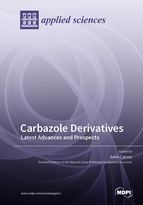Carbazole Derivatives: Latest Advances and Prospects
A special issue of Applied Sciences (ISSN 2076-3417). This special issue belongs to the section "Applied Biosciences and Bioengineering".
Deadline for manuscript submissions: closed (20 August 2022) | Viewed by 13420
Special Issue Editor
Interests: carbazole derivatives; heterocyclic compounds synthesis; antioxidants; medicinal chemistry; medicinal compounds synthesis
Special Issues, Collections and Topics in MDPI journals
Special Issue Information
Dear Colleagues,
In recent years, plenty of research has been aimed at the multiple properties of different carbazole derivatives. Carbazoles are important aromatic heterocyclic compounds isolated from plants, such as those of the genera Ochrosia, Murraya, Glycosmis, and Clausena, or synthetically obtained.
Today, many carbazole derivatives are widely studied as photoconductive, anti-bacterial, anti-fungal, anticancer, antioxidant, anti-inflammatory, anti-Alzheimer, anti-malarial, anti-tuberculosis, and anti-viral agents, for the treatment of obesity and for their psychotropic and anti-histamine activities. However, the therapeutic applications and benefits of some of these derivatives remain low because of their low hydrosolubility, low bioavailability, and the onset of some side effects.
For these reasons, the purpose of this Special Issue "Carbazole Derivatives: Latest Advances and Prospects" is to report the molecular modeling, synthesis, and biological evaluation of new carbazole derivatives with improved pharmacokinetic and pharmacodinamic properties for their development in medicinal chemistry.
Dr. Anna Caruso
Guest Editor
Manuscript Submission Information
Manuscripts should be submitted online at www.mdpi.com by registering and logging in to this website. Once you are registered, click here to go to the submission form. Manuscripts can be submitted until the deadline. All submissions that pass pre-check are peer-reviewed. Accepted papers will be published continuously in the journal (as soon as accepted) and will be listed together on the special issue website. Research articles, review articles as well as short communications are invited. For planned papers, a title and short abstract (about 100 words) can be sent to the Editorial Office for announcement on this website.
Submitted manuscripts should not have been published previously, nor be under consideration for publication elsewhere (except conference proceedings papers). All manuscripts are thoroughly refereed through a single-blind peer-review process. A guide for authors and other relevant information for submission of manuscripts is available on the Instructions for Authors page. Applied Sciences is an international peer-reviewed open access semimonthly journal published by MDPI.
Please visit the Instructions for Authors page before submitting a manuscript. The Article Processing Charge (APC) for publication in this open access journal is 2400 CHF (Swiss Francs). Submitted papers should be well formatted and use good English. Authors may use MDPI's English editing service prior to publication or during author revisions.
Keywords
- carbazole derivatives
- medicinal chemistry
- drug development
- heterocyclic compounds
- biological properties
- docking simulation
- enhanced cellular uptake
- innovative vehicles






